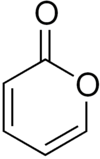2-Pyrone
 | |
| Names | |
|---|---|
| IUPAC name
Pyran-2-one | |
| Other names
α-Pyrone 2-Pyranone 2H-Pyran-2-one | |
| Identifiers | |
| 504-31-4 | |
| ChEBI | CHEBI:37965 |
| ChemSpider | 61462 |
| Jmol interactive 3D | Image |
| PubChem | 68154 |
| |
| |
| Properties | |
| C5H4O2 | |
| Molar mass | 96.08 |
| Density | 1.197 g/mL |
| Boiling point | 102 to 103 °C (216 to 217 °F; 375 to 376 K) at 20 mmHg |
| Except where otherwise noted, data are given for materials in their standard state (at 25 °C [77 °F], 100 kPa). | |
| | |
| Infobox references | |
2-Pyrone (α-pyrone or pyran-2-one) is an unsaturated cyclic chemical compound with the molecular formula C5H4O2. It is isomeric with 4-pyrone.
2-Pyrone is used in organic synthesis as a building block for more complex chemical structures because it may participate in a variety of cycloaddition reactions to form bicyclic lactones. For example, it readily undergoes Diels-Alder reactions with alkynes producing, upon loss of carbon dioxide, substituted benzenes.[2] The Gogte Synthesis (1938) is a method for the alkylation of certain pyrones with acid chlorides.
The most common natural products containing a 2-pyrone are the bufanolides and kavalactones. Oxovitisin A, a pyranoanthocyanin found in wine, also contains a 2-pyrone element.
See also
References
- ↑ 2H-Pyran-2-one at Sigma-Aldrich
- ↑ Woodard BT, Posner G H (1999). "Recent Advances in Diels-Alder Cycloadditions Using 2-Pyrones". Advances in Cycloaddition 5: 47–83.
This article is issued from Wikipedia - version of the Wednesday, July 15, 2015. The text is available under the Creative Commons Attribution/Share Alike but additional terms may apply for the media files.